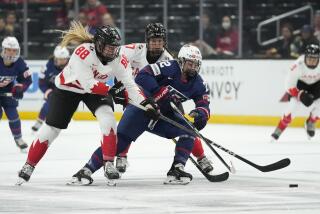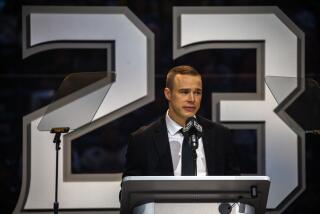Cammi Granato, Angela James are worthy of highest honor
Their journey began like so many others.
Cammi Granato couldnât wait to come home from school and play hockey in the basement of her familyâs home in Downers Grove, Ill., outside Chicago. One of two girls among six kids, sheâd wrestle and tussle with her brothers and play goal if thatâs what it took to get in the game. She dreamed of wearing a Blackhawks uniform someday and was crushed when she realized that door was closed to her.
For Angela James, playing hockey was something all the kids did in her Toronto neighborhood. It didnât matter that she usually was the only girl as she refined the skills that earned her the nickname of the Wayne Gretzky of womenâs hockey.
Their pioneering trails converged Monday in Toronto, where they became the first female players inducted into the Hockey Hall of Fame.
Also inducted in the player category was winger Dino Ciccarelli, who scored 608 goals in a 19-season NHL career. Elected as builders were Jimmy Devellano, who has seven Stanley Cup rings as an executive with the New York Islanders and Detroit Red Wings, and, posthumously, Daryl âDocâ Seaman, who was instrumental in bringing the Flames to Calgary.
âItâs monumental for the game because this prestigious group is including us, believing in us, supporting us, and that says more than anything,â Granato told reporters in Toronto after receiving her Hall of Fame ring Monday.
Hall of Fame selections often trigger debate and complaints, but thereâs a misconception that Granato and James got spots that could or should have gone to male players. Thatâs not true, because they were elected under a new rule that allows for up to two female inductees in addition to four male inductees. Donât like which men were selected? Blame the secretive selection committee.
James, who was at her peak before womenâs hockey made its Olympic debut in 1998, and Granato, a two-time Olympian and captain of the champion U.S. team at the Nagano Games, earned this because they popularized the game and led strong growth among women participants in the U.S. and Canada. Their career statistics matter less than their perseverance each time someone told them no, girls canât do that.
âProud would probably be an understatement,â Tony Granato, a former King and one of Cammiâs older brothers, said of her enshrinement. âYou think about growing up playing hockey and all the things that she had to go through.
âTo open the doors to women hockey players is, I think, courageous on their part because I think they understand where the gameâs come and how exciting it is. I still think it took a lot of courage to say, âLetâs look at the girls and see if we can find someone deserving.â They found a couple that belong in that class of player.â
Congratulations also to veteran Montreal journalist Marc DeFoy, winner of the Elmer Ferguson award for excellence in hockey journalism, and Ron Weber, original voice of the Washington Capitals and winner of the Foster Hewitt award for excellence in hockey broadcasting.
Slap shots
Two proposed rule changes are expected to be discussed when NHL general managers meet Tuesday in Toronto.
Floridaâs Dale Tallon has suggested allowing a coach to challenge one goal-related play per game within certain time limits, and only if the coach has a timeout left. If the challenge is rejected after review that team would lose its timeout. If the challenge is upheld, the timeout would not be lost. A delay of game penalty might be a better deterrent against wasteful use of a challenge, and thatâs one provision that would have to be hammered before it could be adopted.
The other change, conceived by Detroitâs Ken Holland in response to an increase in shootouts, would alter the overtime format. Overtime would be expanded from five minutes to eight, with the first four minutes played four-on-four. If thereâs no winner, teams would then skate three-on-three before resorting to a shootout.
That seems more gimmicky than the shootout itself, but general managers might be willing to consider alternatives after the percentage of games decided by shootouts rose from 12.9% in the 2008-09 season to 15% last season.
twitter.com/helenenothelen
More to Read
Go beyond the scoreboard
Get the latest on L.A.'s teams in the daily Sports Report newsletter.
You may occasionally receive promotional content from the Los Angeles Times.







